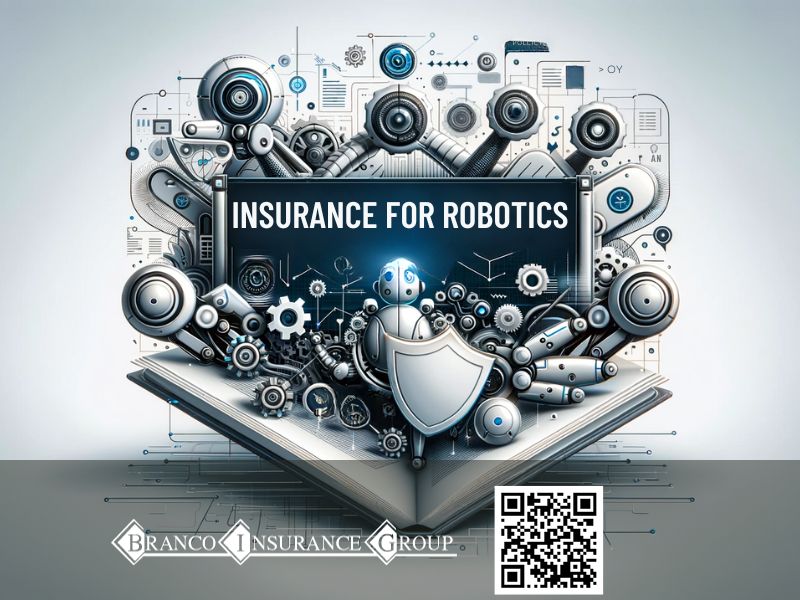The robotics industry is advancing at a rapid pace, transforming how businesses operate across many sectors. As adoption of robotics technologies accelerates, companies that design, manufacture, or utilize robots face emerging risks that require specialized insurance coverage. This article provides an in-depth look at the key types of robotics insurance businesses need and what factors influence the cost of coverage.
What is Robotics Insurance?
Robotics incorporates a broad range of automated machinery and systems that can sense, move, and perform tasks with speed, precision, and accuracy beyond human capabilities. From manufacturing robots on assembly lines to autonomous vehicles delivering packages, these technologies are becoming deeply integrated into commercial operations.
However, utilizing robots comes with inherent dangers if accidents or system failures occur. Without proper insurance, robotics companies can face substantial financial losses from third-party bodily injury and property damage claims, product defects lawsuits, professional errors and omissions complaints, data breaches, and damage to valuable equipment and facilities.
Specialized robotics insurance protects against these liabilities by bundling together packages of coverage tailored to the unique risks involved. Policies may include:
- General liability insurance: Covers third-party bodily injury and property damage claims stemming from a company’s premises, operations, products, or completed work.
- Products liability insurance: Safeguards manufacturers and sellers against financial loss arising from injury or damage caused by a faulty product.
- Professional liability insurance: Protects against claims alleging inadequate work or services like software programming errors.
- Cyber liability insurance: Defends against lawsuits and damages related to data breaches, computer virus transmission, and other cyber incidents involving robots or back-end systems.
- Property insurance: Reimburses damage or loss of a business’s property due to disaster, theft, or other hazards. Essential for expensive robotics equipment and facilities.
Why Robotics Companies Need Insurance
There are several reasons why insurance is an absolute necessity for businesses involved in robotics:
- Expensive equipment: From specialized industrial robots costing over $100,000 to prototypes still in development, insuring expensive machinery, components, and facilities is vital for managing risk.
- Product defects: Faulty mechanical parts, software bugs, or electrical failures can lead to robot malfunctions and substantial injury or property damage claims needing insurance protection.
- Third-party lawsuits: Without coverage, legal claims and lawsuits can quickly cripple companies if robots directly harm people or property.
- Cyber incidents: Connected systems face evolving data breach and cyber attack risks needing specialized insurance.
- Business continuity: Suffering a large uninsured loss can severely hurt productivity and revenue. Proper insurance facilitates swift recovery.
- Investor requirements: For robotics startups raising venture capital, investors will require insurance coverage to ensure their investment is protected.
In short, robotics insurance shields companies from financial ruin so they can focus on innovation. The consequences of going uninsured can be disastrous.
Key Types of Robotics Insurance Coverage
Specialized policies have emerged to cater to robotics companies based on their unique operations and risk exposures. The most essential coverages include:
General Liability Insurance
General liability insurance is one of the most fundamental coverages robotics businesses need to carry. It protects against third-party bodily injury, property damage, personal injury, and advertising injury claims stemming from a company’s:
- Premises (e.g. a visitor trips and falls within a facility)
- Operations
- Products (e.g. a component part fails causing a robot to damage property)
- Completed work
For robotics manufacturers, having sufficient general liability limits ensures protection if a product defect or software problem causes large-scale damage. For businesses utilizing robotics operationally, it shields them against premises accidents.
General liability insurance for robotics will provide defense costs against covered claims and damages awarded – up to the defined limits of the policy. Typical policy limits range from $1 million up to $5 million or higher depending on the exposure risk. Deductibles generally range from $5,000 to $50,000+.
Products Liability Insurance
For companies that manufacture, sell, or supply robotic technologies, product liability insurance is compulsory to manage risk. This coverage specifically applies to financial harm arising when a product fails or malfunctions, leading to third-party property damage or bodily injury.
Lawsuits stemming from faulty design, software defects, or manufacturing flaws in robots can be complex and costly to defend without insurance protection. And with robots regularly costing 6 or 7-figures, damages can eclipse policy limits quickly.
Product liability insurance responds when it can be proven a robot or component part was defective. However, the coverage usually excludes damage to the actual product itself – only covering third-party claims.
Other inclusions with product liability insurance include coverage for financial injury when a product fails to perform as intended and causes purely financial harm. Consulting services related to products may also be covered.
Professional Liability Insurance
Also referred to as errors and omissions (E&O) insurance, professional liability insurance is imperative coverage for robotics companies to carry. It responds to third-party claims alleging poor workmanship, planning errors, negligent actions, or failure to perform professional duties.
For robotics engineers, programmers, consultants, and research teams, E&O insurance is invaluable protection against potential software flaws, design defects, calculation errors, mistakes in technical drawings, and more. Without it, a coding error that causes a robotics system failure could lead to massive lawsuits and damages.
Typical policy limits for professional liability insurance range from $1 million to $5 million. However, limits are usually written on a claims-made basis rather than an occurrence basis. This means limits apply per policy period rather than per event. Larger organizations may opt for higher limits.
Cyber Liability Insurance
With robotics systems heavily utilizing connected technologies and collecting expansive data, exposures to cyber incidents run high. Hackers tapping into robots could potentially utilize them for dangerous hacking missions. They also have valuable onboard data vulnerable to theft.
Cyber liability insurance covers the emerging digital risks robotics companies face, including:
- Data breaches leading to stolen personal records or trade secrets
- Ransomware attacks that deny system access until funds are paid
- Hacks misusing robots for malicious purposes
- Bricking equipment through malware
- Violations for privacy policies or data mishandling
Policies cover costs around incident response, forensic investigations, legal services, notifications, public relations mitigation, fines and penalties, and loss associated with system downtime or corrupted data.
With hackers growing more sophisticated, ensuring robots have multilayered cyber protections is critical along with cyber liability insurance backing. Else companies risk major lawsuits and damages without coverage.
Property Insurance
Property insurance is essential but often overlooked coverage for robotics operations insuring the physical assets. Policies reimburse repair or replacement costs to damaged or lost business property caused by:
- Fire, smoke, weather damage
- Theft
- Vandalism
- Electrical surges
- Equipment breakdown
- Water damage
For robotics companies, this means all-important coverage for the expensive electronics and machinery on-premises and in development facilities against unforeseen disasters. Other inclusions like valuable papers coverage for lost blueprints, plans, and research notes and equipment breakdown protection for short-circuiting appliances are useful additions as well.
Insuring property to full replacement value using an agreed amount rather than a coinsurance model ensures efficient reimbursing of vital equipment and facilities.
What Influences the Cost of Robotics Insurance?
Robotics insurance can vary widely in pricing based on risk exposures influencing premium costs:
Industry Classifications
Insurers classify robotics into sectors like manufacturing, aviation, agriculture, pharmaceutical, logistics, security, retail, and more. Industries utilizing robotics in high-risk applications like security drones, warehouse machinery, or autonomous vehicles generally face steeper rates.
Prototype vs. Commercial System
A newly launched robot with minimal testing and safety precautions in place scores higher rates than a longstanding commercial model with years of accident-free data. Costs steadily decline as more data supports reliable risk metrics.
Level of Autonomy
Fully autonomous robotics devoid of human operators have better risk scoring than robots requiring a mix of independence and human oversight. However, specific applications also influence pricing like self-driving trucks vs. warehouse bots.
Business Specifications
Factors like years in business, revenues, and experience with robotics all sway cost. Newer startups see higher premiums while long-tenured corporations with yearly audits and advanced safety engineering controls enjoy lower rates.
Regulatory Landscapes
Insurers consider shifting regulations governing autonomous robots and differing state laws permitting various robotic uses – all influencing risk. More uncertainty means elevated pricing until precedents stabilize.
Safety & Risk Protocols
Robotics companies investing in multilayered failsafes, security protocols, worker training programs, and robust product testing enjoy significantly lower premium costs reflecting diligent risk management and accident avoidance measures.
Insurers utilize complex proprietary algorithms weighing these criteria and historical loss data from robotics claims to shape pricing suitably for each unique risk. As more insurers embrace offering tailored robotics coverage, costs should become more competitive.
Safeguarding Robotics with Insurance
Robotics promises to transform nearly every domain as the supporting technologies progress. But with innovation comes risk. Companies have a responsibility to implement adequate protections for workers, the public, and shareholders as robots capable of harm are created and commercialized.
Specialized insurance designed specifically for robotics provides an indispensable safeguard by covering emerging liability risks innovation presents. And with tailored policies now available from leading global insurers, companies have access to coverage supporting responsible development so robots can continue pushing boundaries improving society.
Final Thoughts
At Branco Insurance Group, our goal is to protect what matters most – your family and your business. As an independent agency working with top carriers, we have the knowledge and experience to find you tailored coverage at competitive rates.
Whether you need to insure your home, auto, health, or business assets, our local team of experts makes it easy by listening to your unique needs. We aim to provide superior service and build lasting relationships, not just sell policies. Our 5-star client reviews are evidence that we deliver on that promise.
Unsure what policies match your situation or budget? Contact us today for a free consultation. We’ll answer all your questions in plain language, explain your options, and provide customized recommendations without pressure. Protecting your livelihood and loved ones is serious – and we take that seriously. With Branco Insurance Group as your partner, you can have confidence and peace of mind knowing you made the right choice.





